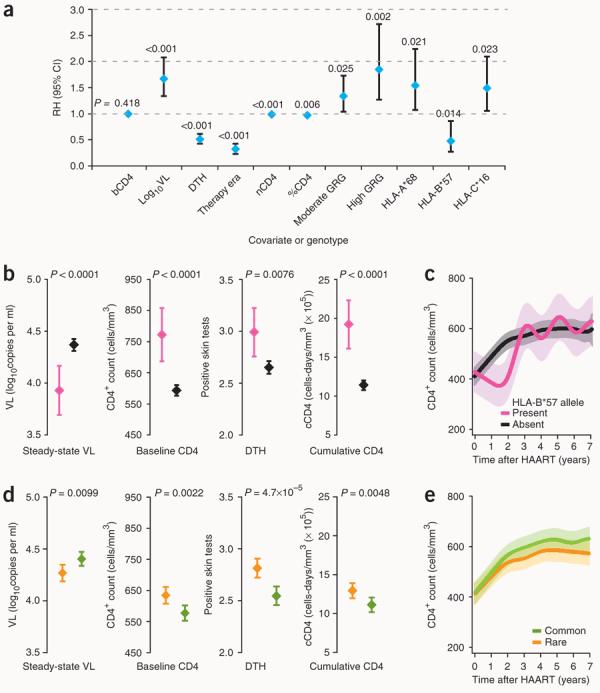Figure 3.

Influence of HLA alleles on early events and CD4+ T cell dynamics in subjects from the WHMC HIV+ cohort. (a) Independent disease-modifying effects of HLA alleles. The plot shows the relative hazards (RH, diamonds) and 95% confidence interval (CI, error bars) for rates of progression to AIDS for the variables listed along the x-axis. Results are derived from the final model using stepwise multivariate Cox proportional hazards regression analyses for time to AIDS (1987 Centers for Disease Control criteria) and are based on data from 719 European- and African-American subjects from the WHMC HIV+ cohort. bCD4, baseline CD4+ T cell count; VL, steady-state viral load; nCD4, nadir CD4+ T cell count during HIV disease course; %CD4, percentage of baseline CD4+ T cell counts; these parameters as well as the therapy era and DTH skin test reactions are as described previously3. The RH (95% CI) for bCD4, nCD4 and %CD4 are 1.00 (0.99 – 1.00), 0.99 (0.99 – 0.99) and 0.97 (0.96 – 0.99), respectively. (b) Association of the HLA-B*57 allele (pink, present; black, absent) with parameters that reflect early immune damage (steady-state VL, baseline CD4, DTH responses) and cumulative CD4+ T cell counts. Diamonds and error bars represent the mean and 95% CI, and the P values were obtained using the Student's t-test. (c) Recovery of CD4+ T cell counts after initiation of HAART on the basis of possession of a HLA-B*57 allele (by nonlinear GEE). (d) Association of HLA class I allele frequency score groups (low score representing rare (orange) and high score representing common (green) class I HLA alleles) with the indicated parameters. (e) Recovery of CD4+ T cell counts after initiation of HAART on the basis of the HLA class I allele frequency score groups representative of rare and common HLA class I alleles (by nonlinear GEE).
